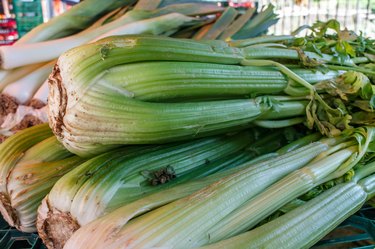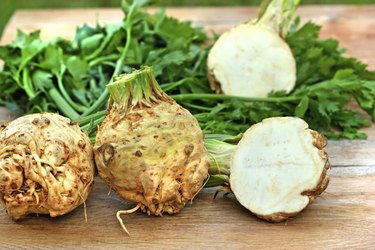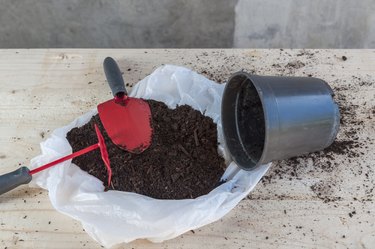Celery plants have thick, succulent stalks, aromatic roots or fresh leaves -- depending on the type of plants. The celery often seen in grocery stores is Apium graveolens var. dulce, which grows as tall clumps of thick stalks; celery varieties for growing in the home garden include the traditional white, blanched celery and self-blanching and red-stalked types.
Celeriac (Apium graveolens var. rapaceum) -- also called celery root -- is a type of celery that's grown for its large, swollen, brown-skinned root, and leaf celery (Apium graveolens secalinum) supplies savory leaves that are added to soups and stews. Celery, celeriac and leaf celery are biennial or perennial plants usually grown as annuals.
Video of the Day
Video of the Day
Tip
Celery, celeriac and leaf celery grow poorly at temperatures higher than about 75 degrees Fahrenheit, and produce flowers and seed prematurely when exposed to temperatures lower than 55 F.
Warning
Both celery and celeriac are invasive in some areas of the United States.
Growing Celery and Celeriac
Celery and celeriac grow best in fertile, freely draining soil in full-sun spots, which receive at least six hours of direct sunlight every day. Celery and celeriac seeds should be sown about 10 weeks before your average final spring frost date.
Celery Cultivars

'Utah 52-70 R Improved'
Maturing in 100 to 120 days, 'Utah 52-70 R Improved' grows 11 to 12 inches tall, with stringless bright green stalks. This celery type can be sown through spring and is harvested in fall. In areas that don't experience freezes, Utah 52-70 R Improved provides stalks through the winter.
'Golden Self Blanching'
Celery is usually blanched to produce white, sweet stalks, which means the stalks are buried in soil or wrapped to prevent light from reaching them, but 'Golden Self Blanching' celery produces golden yellow stalks with no blanching. Growing 18 to 23 inches tall, this celery is ready to harvest 85 to 103 days from sowing.
'Redventure Celery Organic'
'Redventure Celery Organic' has burgundy, brilliant red and golden pink stalks, and matures in 100 to 110 days.
Celeriac Varieties

'Brilliant'
'Brilliant' celeriac produces white, fiberless roots 3 to 5 inches in diameter. An early maturing variety, Brilliant is ready for harvest about 110 days after sowing.
'Ehud'
A short season celeriac variety, 'Ehud' matures about 70 days after sowing. 'Ehud roots are dense, nearly fiberless and ivory-colored, and 2 1/2 to 4 1/2 inches in diameter.
Types of Leaf Celery
Leaf celery prefers sandy or loamy, freely draining soil, and it can grow in full-sun spots or light shade. It also tolerates highly alkaline and acidic soil.

'Cutting Leaf Celery'
Growing 8 to 12 inches tall, 'Cutting Leaf Celery' produces dark-green rounded leafy stalks that are thin and flexible, and ready for harvest about 85 days after sowing. Its compact size makes it good for growing in containers.
'Par-Cel'
'Par-Cel' is a curly leaved leaf celery that grows up to 3 feet tall. Tolerating heat and drought better than other varieties, Par-Cel matures in about 72 days.